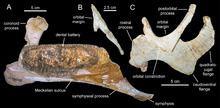Family †Hadrosauridae Phylum Chordata | Class Reptilia Suborder †Ornithopoda Rank Genus | |
 | ||
Similar Arenysaurus, Pararhabdodon, Barilium, Canardia, Amurosaurus | ||
Blasisaurus is a genus of lambeosaurine hadrosaurid dinosaur from the Late Cretaceous. It is known from a partial skull and skeleton found in late Maastrichtian-age rocks of Spain. The type species is Blasisaurus canudoi, described in 2010 by Penélope Cruzado-Caballero, Xabier Pereda-Suberbiola and José Ignacio Ruiz-Omeñaca, a group of researchers from Spain.
Contents
Naming and discoveryEdit
The generic name refers to the Blasi 1 site where the fossil was found. The specific epithet honours paleontologist José Ignacio Canudo. The holotype, MPZ99/667, is housed in Huesca. It was found in a layer of the Arén Formation dating from the upper Maastrichtian, about 66 million years old. It consists of a skull with fragmentary lower jaws.
DescriptionEdit
Blasisaurus is a medium sized euornithopod. The describers have been able to identify two distinct features: the cheekbone has a rear projection with a hook-shaped upper edge, and the lower sleep window is narrow and D-shaped. From the same formation is Arenysaurus, a related species. They are not identical, distinguished by the shape of the teeth and missing secondary ridges. Blasisaurus also differs from Koutalisaurus by a downwardly bent front edge of the lower jaws.
PhylogenyEdit
The describers performed an exact cladistic analysis to determine its phylogenetic position. The outcome of the phylogenetic analysis placed Blasisaurus as the sister taxon to Arenysaurus. Together they form a clade that is higher in Lambeosaurinae than Tsintaosaurus and Jaxartosaurus. Whether this clade was more derived than Amurosaurus, the closest relative of the group, was not determined. However, one study did find that they were not sister taxa, no other studies supported this. Blasisaurus confirmed the hypothesis that in the Late Cretaceous, different Hadrosaurids from Asia and Europe was a sign that they migrated across land bridges that must have been present. Where in lambeosaurinae Blasisaurus and Arenysaurus fall is disputed. They have been found to be in lambeosaurini, as basal to the Lambeosaurini-Parasaurolophini split, and in Parasaurolophini. Below is the most recent cladogram published including Blasisaurus and Arenysaurus, found by Penélope Cruzado-Caballero et al. in 2013:
